What you actually need to know about the cool streets beneath your hot feet.
You probably don't care about pavement now, but you might after this!
How did we get here?
When Lyn started her job at UCLA, she heard about reflective pavements for the first time. Sonam was on the other coast, exploring these solutions for New York’s 6,000 miles of roads. As strange as it sounds, these were pretty magical experiences for both of us. As far as we could tell, reflective pavements seemed like a silver bullet for our urban heat woes. By using materials of different colors and textures, reflective pavements reflect sunlight off of a street’s surface and back up into the sky, away from humanity on the streets below. What more could we ask for?
Our city streets are an enormous contributor to the urban heat island effect — in fact, roads occupy a whopping 20-30% of all urban surface land area in most US cities! And unlike sidewalks, we can’t easily cool down large urban streets with misters, trees, and shade structures. This means that traditional asphalt pavements are often directly exposed to the sun, and can reach temperatures as high as 120 to 150 degrees Fahrenheit. This direct sun bakes the streets, which absorb and store that heat like a city-sized pizza stone. Then, that heat is slowly released back into the city after the sun goes down, contributing to the urban heat island and reducing the relief we could feel from the cooler night air.
So it matters a lot that reflective pavements reflect sunlight off our street surfaces. In theory, this should reduce the amount of heat that’s absorbed and stored by our cities. This is a big deal because extreme heat causes over half a million deaths every year, and that number will only increase as the world gets warmer. This is super exciting, but when we were first learning about reflective pavements, most of our evidence didn’t yet exist in the real world. We only had studies with simulations and models, or small-scale lab experiments. But there weren’t many solutions that had come out of the PDF reports and into the real world.
Over the last 3+ years, this has changed for the better. There have been several major pilot projects and real world studies using reflective pavements. We read through all of the studies, visited the pilot sites, and interviewed the people running these programs. Today, we're dropping all that knowledge in one (admittedly long) post.
This isn’t going to be an exhaustive overview of all the science on reflective pavements. It is going to be an overview of all the claims both in support of and against reflective pavements that we think are interesting and important to explore.
Note: This is our first post with footnotes. There are SO many important points to make here, so we're using footnotes to organize this information for you. You can find those additional details, definitions, and clarifications at the bottom!
First, a quick rundown of how reflective pavements work:
Reflective pavements take advantage of differences in color and texture to reflect more light and heat back into the atmosphere. This means it has a higher solar reflective index, or albedo. Albedo is measured on a scale of 0 to 1, and a higher albedo means that a reflective pavement should absorb and store less heat, which should in turn reduce the urban heat island effect.
Reflective pavement coatings are occasionally made with polymers (binding chemicals that are also in your house paint!) and tend to be more energy and carbon intensive than regular asphalt coatings.
As scientific interest has grown in reflective pavements, so has the sophistication of reflective pavement products. Interest first focused on using concrete, rather than much darker-colored asphalt, for reflective pavements. That evolved into concrete that was specifically engineered to be more reflective, and eventually to other materials. Today, we have a lot of options for reflective pavements, though the most popular ones are coatings1 that are painted onto existing city streets (typically asphalt). The most popular coatings come from GAF and Coolseal!
Ok, let’s move onto the important claims.
Claim #1: Reflective pavements will make our streets less hot.
Verdict: Confirmed!
The Evidence:
When we say that pavements will make streets less hot, we mean the literal surface of streets. Across all of the literature we’ve reviewed, reflective pavements have been pretty effective at keeping surface temperatures lower. A recent study out of Arizona State University (ASU) that evaluated the City of Phoenix reflective pavement pilot program found differences as large as 15 degrees Fahrenheit!
This does come with some caveats, of course. While doing site visits, we used our thermometer laser to measure the surface temperature of several reflective pavements, and nearby regular pavements. We often found temperature differences that were closer to about 5 degrees Fahrenheit, but this difference depends on the time of day. This is totally anecdotal of course, but we thought it was informative, and helped us ground-truth the numbers we had seen.

The ASU study offers another perfectly reasonable explanation for the discrepancy between lab estimates and our real-world measurements: reflective pavements get less reflective over time.
This is most likely due to the fact that over time, reflective pavements get dirty just like any other street. Cars leave tire marks, dust accumulates, and this darkens the pavement and reduces its reflectivity, and therefore its effectiveness.
Claim #2: Reflective pavements will reduce the impacts of heat on cities and people.
Verdict: We really don’t know yet.
The Evidence:
Turns out, this is actually still an open question and a potential point of debate. To find out more, we rang up Dr. Florian A Schneider, the lead author of the ASU study we mentioned above. He was incredibly clear and candid. “If there were no people in cities, we could easily deploy solutions that would create significant temperature reductions without caring much about some trade-offs. But the goal of cooling an urban area is to benefit people,” he said.
Dr. Schneider’s research showed mixed results to that end. On one hand, there were almost no statistically significant differences in actual air temperature. But that doesn’t necessarily mean that reflective pavements don’t cool the air. Rather, this might be due to limitations of the experiment such as the measurement tools including infrared sensors and custom carts to measure radiant temperature, measurement locations, and even the relatively small scale of the experiment.2 Some newer studies were recently launched in Pacoima to address these exact issues and evaluate air temperature with more accuracy. We're excited to see where that science goes!
The biggest point of contention, however, arises from the claim that reflective pavement may actually make the environment hotter for people.
Two major studies — Dr. Schneider’s recent publication and a 2020 study from ASU’s Dr. Ariane Middel — have both shown significant increases in radiant temperature3 during the hottest parts of the day due to reflective pavements. (It's important to note that those increases were only seen directly above the pavements, but not on adjacent sidewalks.) The radiant temperature is an objective measure of how hot people feel in dry and hot environments, and it is notably different from air or surface temperature. However, these studies also show that reflective pavements decrease radiant temperature after sunset and throughout the night.
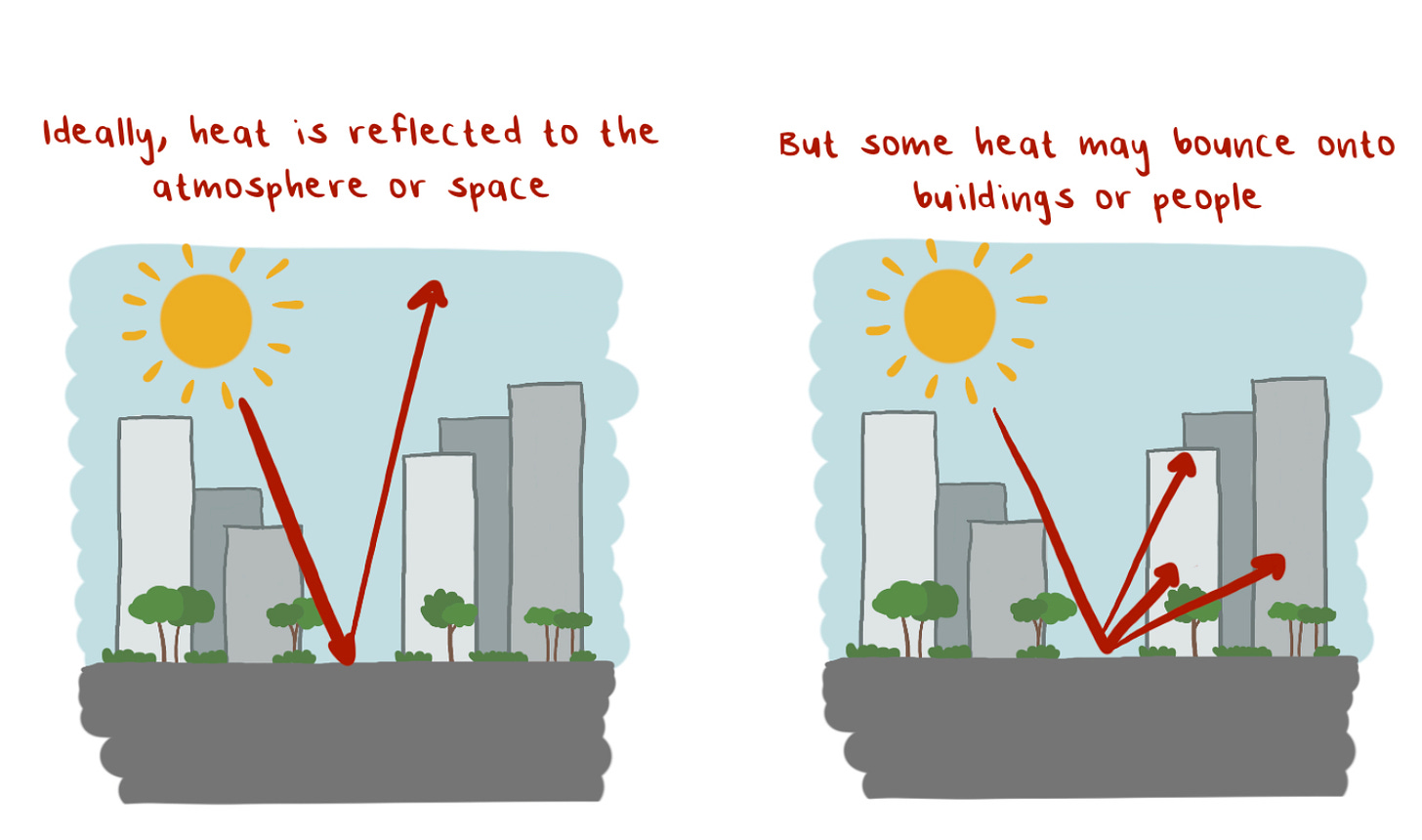
These results raise an interesting question: what trade-offs are we willing to make? In 2020, Phoenix had over 50 days where the high temperature was over 110 degrees Fahrenheit — and given the rate of global warming, this could get much worse before it gets better. During our visit to Phoenix and its neighboring cities, most people were taking shelter in air conditioned buildings during that time anyway. Maybe this means that we’re ok with increases in radiant temperature over our streets during those hours. On the other hand, high night-time temperatures are especially dangerous for people's health.4 This means that the cooling benefit of reflective pavements at night may be worth the hotter radiant temperatures during the day.
In short, the jury is still out on this one. There are clear indicators that reflective pavements have the potential to cool our cities, but not without some trade-offs.
Claim #3: Pavements will create energy savings, lowering costs and carbon emissions.
Verdict: Probably not.
The Evidence:
The idea behind this claim is that if reflective pavements reduce the urban heat island effect, then that will reduce the need for air conditioning in nearby buildings.
Unfortunately, it doesn’t look like that’s the case. A study out of Lawrence Berkeley National Lab showed that even in the most optimistic scenarios, reduced energy use thanks to reflective pavements would lead to incredibly small cost savings and peak power demand. In fact, given the results of the ASU studies, we’re curious if the reflective pavements may actually increase the need for air conditioning and electricity during the hottest times of the day.
We can turn back to Dr. Schneider for more context. He explained that during the day, the angle of the sun may lead reflections to bounce off of reflective pavements and back into and onto buildings, heating them up and increasing the need for air conditioning. This is backed up by a 2020 MIT report, which used a simulation to show that reflective pavements could actually lead to a net increase in greenhouse gas emissions. Yet, this hasn’t been measured in the field.
Claim #4: Reflective pavements will increase the longevity of asphalt streets, and reduce costs.
Verdict: Sort of.
The Evidence:
For this piece, we turn to our interviews with Ryan Stevens, the engineer leading the cool pavement pilot at the City of Phoenix Department of Transportation.
From Stevens's experience, this seems like a pretty resounding “yes”! He shared that typically, the Phoenix DoT has to resurface asphalt pavements every 2-3 years. The product that Phoenix used for their reflective pavement program has an estimated lifespan of about 8 years. So, how has it fared?
Well, the first pavements in Phoenix’s pilot were laid about 3 years ago, and they are showing no significant signs of wear. Ryan says that at this rate, there’s no reason to believe that these pavement coatings won’t last the full 8 years! This is hugely important for the economic case around cool pavements, since Stevens estimated that they currently cost approximately 3x traditional pavements.5
Maintenance, however, may be a slightly different story. Reflective coatings may protect asphalt streets, but they also require maintenance. Remember how ASU’s study showed that reflectivity decreased over time? Well, there were two exceptions to that decrease: after street sweeping, and after the rain. This implies that in order to get the maximum benefits out of reflective pavements, we may need to put more work into keeping them clean. Stevens mentioned that this was an informative finding, and that with the right resources, that’s a goal that he’d like to set for the City of Phoenix. For now though, a major increase in street sweeping services is too resource-intensive for the city.
Claim #5: Reflective pavements will make streets more dangerous.
Verdict: No, if we're careful.
The Evidence:
One of the most commonly cited concerns around reflective pavements is that… they’re reflective. This concern makes a lot of sense in the context of streets, where reflectivity may result in glare, and can mean reduced visibility for drivers, pedestrians, or cyclists on the road.
However, there are a couple of ways that we can mitigate that risk. Stevens shared that an albedo of about .34 is a “goldilocks” reflectivity that creates cooling benefits without creating too much glare for drivers. Dr. Schneider also pointed to this as one area of potential innovation. Currently, reflective pavements reflect both heat and light. However, he’s excited to see material science innovations that allow for reflective coatings to selectively reflect solar radiation in the “near-infrared” range. This is energy outside of the visible spectrum (so no visible glare) and is a major contributor to the urban heat island effect. This is what we're seeing in newer, ongoing studies that show the benefit of surface cooling without glare.
The other important safety concern is around texture. Reflective coatings are smoother than traditional asphalt, so there are concerns there may be less traction for cars when it rains. Dr. Schneider raised an important point: where we put reflective pavements matters, and we need to consider whether they’re a good fit for rainy geographies.
Why all of this information matters.
We need to have really honest and critical conversations about new resilience technologies, reflective pavements included. To sum it up, here are the important take-aways from the state of the science, so far:
The science has a long way to go, but we're making great progress!
If we've learned anything from our research for this piece, it's that the science around reflective pavement is just getting started. This is most apparent in the debate around how we measure heat, and what each metric really means for people. One of the main take-aways from Dr. Schneider's study: the way we measure heat matters.
This was reinforced in our conversation with Dr. Haider Taha of Altostratus. Our current measurement methods — air, surface, and radiant temperatures — can’t singlehandedly tell the whole story of the human experience of heat.
These two conversations showed us that we can't rely on just one heat metric - it tells an incomplete story. For example, ASU's study had several sites that simultaneously showed increases in radiant temperature, but decreases in air and surface temperatures. The work that Dr. Schneider and Dr. Taha are doing is a critical step towards fully understanding the impact of reflective pavements.
Reflective pavements hold promise to help cool our urban environments, but we should be prepared to make trade-offs.
Reflective pavements may increase radiant temperatures, so we should be mindful of its potential impacts on pedestrian comfort. Since many people prefer to stay in air conditioned buildings during the height of a hot summer day, this may be a trade-off we're willing to make. When we're making those decisions, though, we can't forget about the people who can't always take shelter in the AC, such as those who are unhoused or those who have to work or commute outside. These are important climate justice considerations we simply can't ignore when testing and deploying promising new technologies.
We need to be willing to experiment.
We only got this far with reflective pavements because brave, innovative folks like Ryan Stevens in Phoenix are leading the charge for climate resilience in their cities. Every new technology has risks, and we need more people willing to act and experiment.
Plenty of groups are starting to do large scale experiments with reflective pavements across the United States. We’re particularly excited about the work being done by Climate Resolve and Pacoima Beautiful at the city of Pacoima, California. Their GAF-funded study is distinct because they paved a large chunk of the city with reflective pavements, so we may see a bigger impact on air temperatures per monitoring work done by Altostratus Inc. At the same time, Phoenix is ramping up their deployment to understand the impacts of reflective pavements at scale. This year, they'll be coating their 100th mile! There are so many questions that we haven’t yet answered about reflective pavements, and we’ll only get the truth through more careful experimentation.
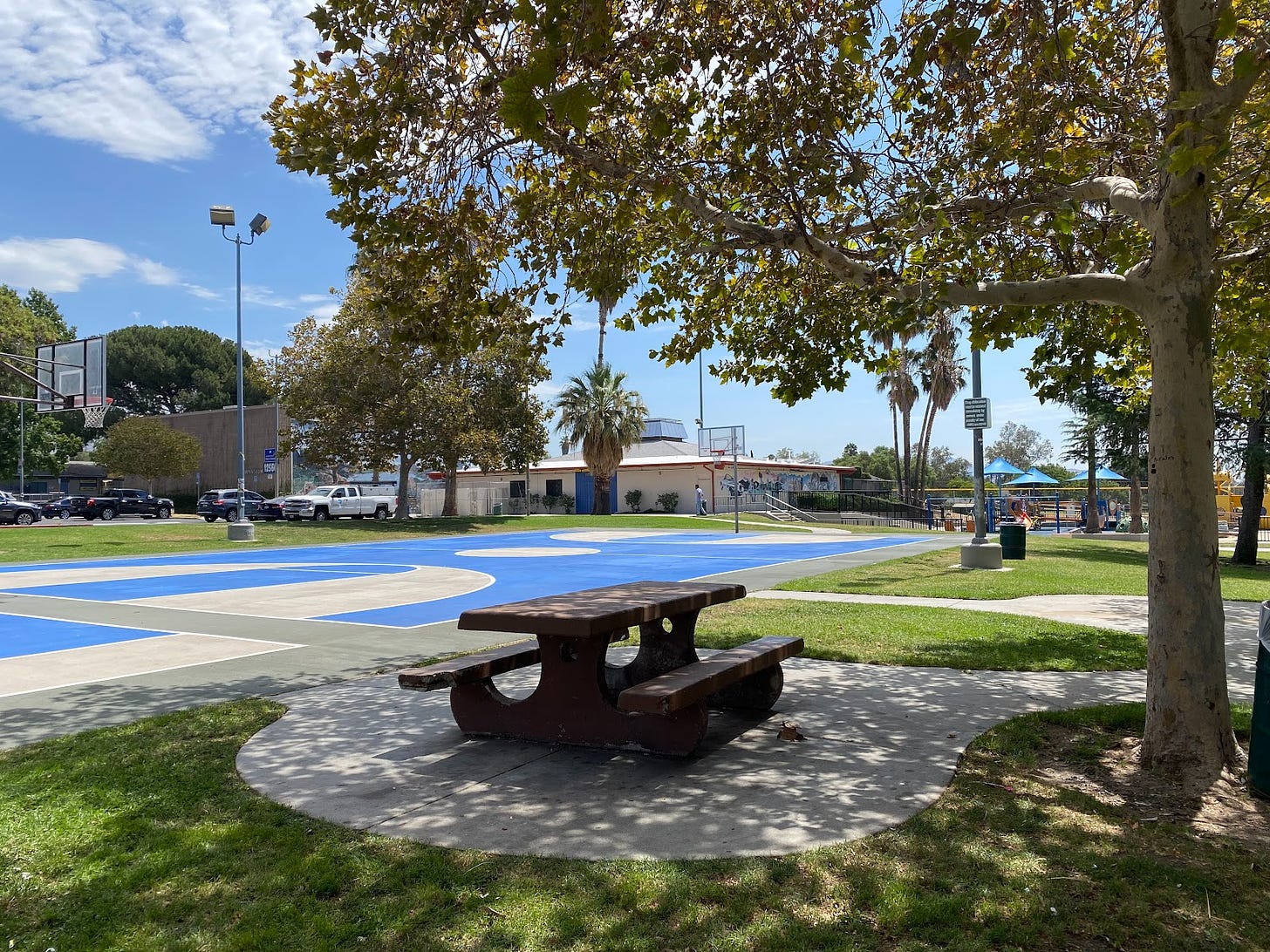
There is a trade-off between designing for the cities we have, and the cities we want.
To us, the most concerning limitations of reflective pavements come from the trade-offs. The potential of glare to reduce road safety and increased radiant temperature over the streets may discourage people from walking or biking. Right now that may not seem like a big deal; America’s cities — especially sprawling cities like Phoenix — are incredibly car dependent. However, more sustainable and climate resilient cities should encourage more people to opt for active transport options. At some point we may have to decide: do we want to design our climate resilience solutions around the cities we have today, or the cities we want to build for tomorrow?
Reflective pavements aren't a silver bullet, but they're part of the silver buckshot.
We've come a long way since we first learned about reflective pavements. It's pretty clear now that they aren't a silver bullet for the urban heat island effect, but they're an important new tool that we can put to use. We hope they'll be used alongside changes in land use, tree planting, shade structures, water features, and all of the other exciting strategies we have to create beautiful streets and neighborhoods globally. With the right innovation and willingness to experiment, reflective pavements will help pave the way for the resilient cities of the future.
Footnotes
The most popular coatings we've come across come from GAF and Coolseal by GuardTop. The pilot project in Pacoima is using GAF. The City of Phoenix has tried several products, but mostly uses Coolseal.
One of the major limitations in the design of ASU's experiment is that even though they paved 36 miles of streets, those street sections were not all concentrated in one location (as it is in the Pacoima project). This may have made it more difficult to detect any cooling benefits, since the compounding effects of a larger, contiguous surface area of reflective pavements was limited.
Radiant temperature is related to the amount of heat that a pavement gives off. During our conversation with Dr. Schneider, he shared that it’s our best estimate of how hot people feel when walking above the pavement. We agree that it seems like a good metric, this can also be a topic of debate as we found out during our conversation with Dr. Haider Taha, the President of Altostratus. Dr. Taha shared that while radiant temperature is a good start, it doesn’t capture a lot of the other variables that make people feel hot or cold — things like wind, humidity, or even sweat.
High daytime temperatures are an important metric, but high night-time temperatures are a major contributor to night-time extreme heat deaths. This is because our bodies, which typically drop in temperature when we sleep, don't have the opportunity to cool down. This can lead to something as simple as sleep disruption, or cause extreme physiological stress, especially to the elderly or those with pre-existing conditions. Our bodies can sweat off up to two liters at night when temperatures are above 85 degrees Fahrenheit, and this may cause severe dehydration in children and the elderly. Heat exhaustion sets in over time, and ultimately, heat strokes can cause severe harm overnight.
Stevens shared that different reflective coatings have different costs to the city. A large portion of these costs are for application, rather than the actual material. Stevens hopes that these costs will come down as more products are designed to be used with existing city equipment. He also hopes to hire more city staff to apply pavements, since this will likely be more cost-effective than hiring contractors.
A heartfelt, special thanks to Dr. Florian A. Schneider, Dr. Haider Taha, Dr. Jonathan Parfrey, and Ryan Stevens for so generously giving us their time for interviews and reviewing this piece for accuracy!

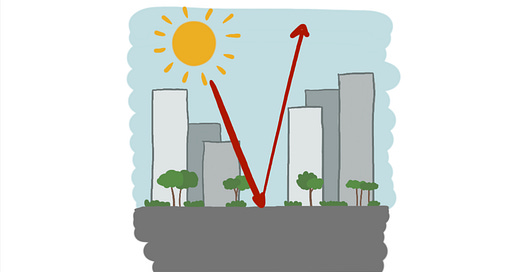




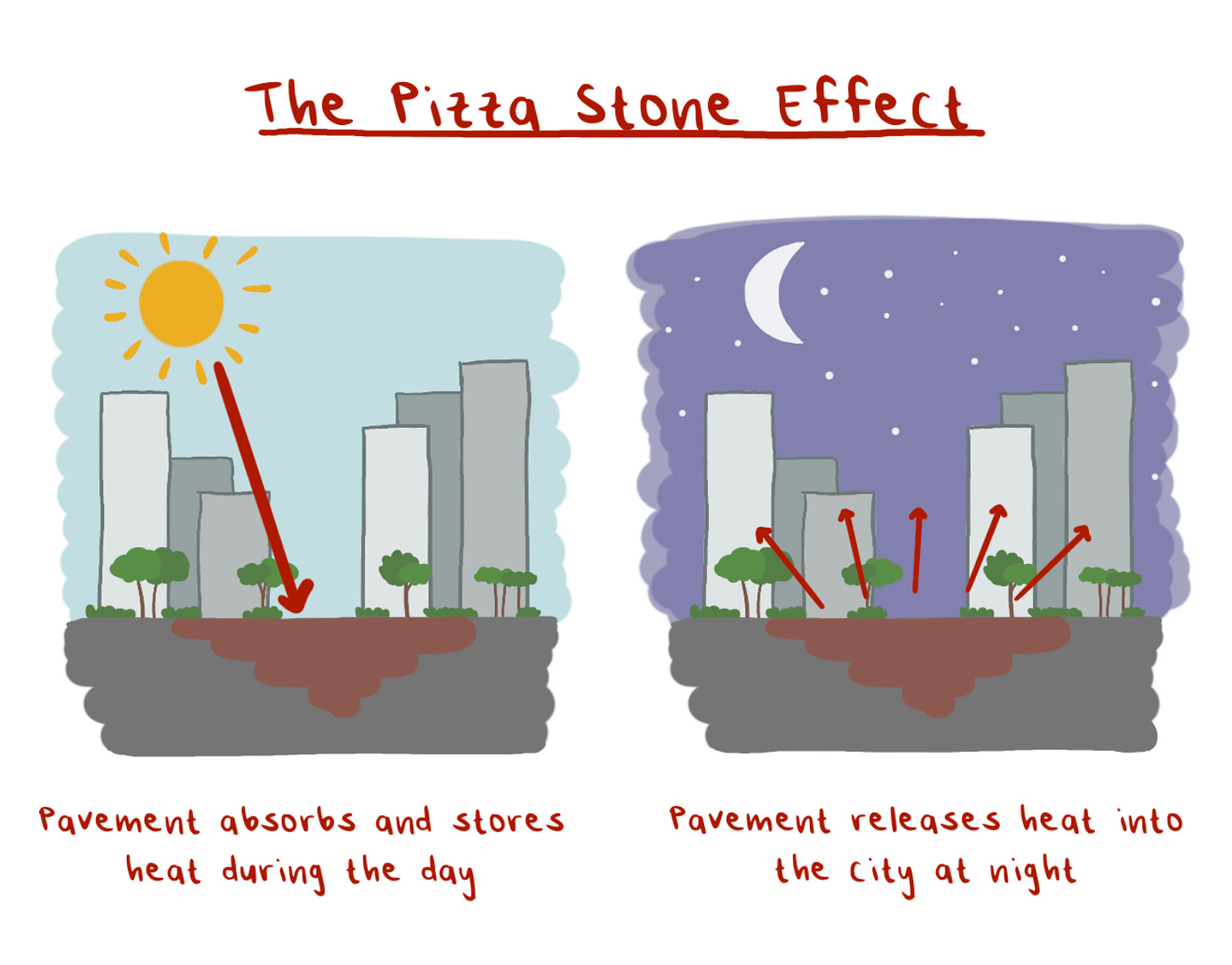

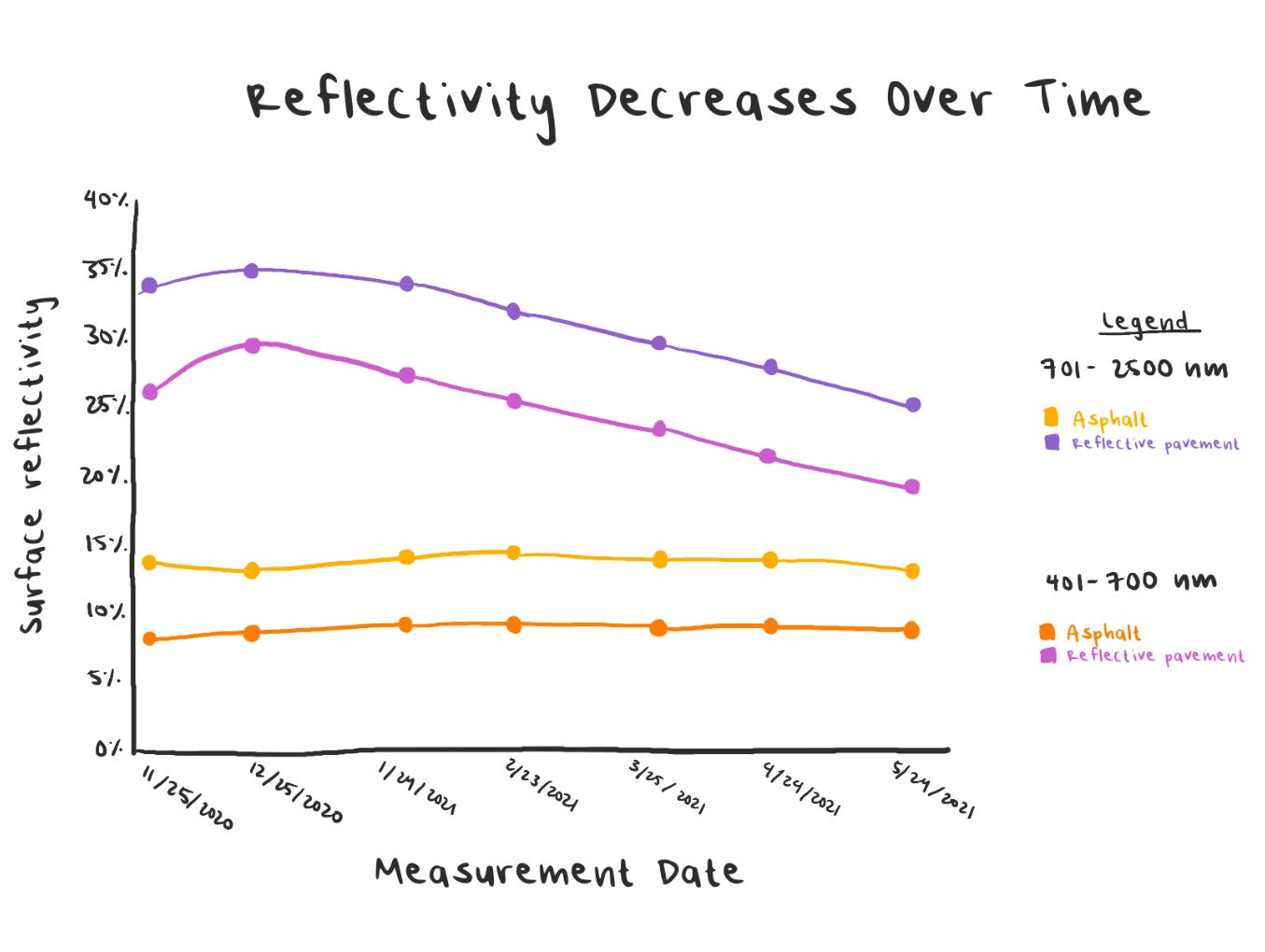


Having grown up in Pasadena from the mid-1950s and moved phoenix in 2016, cooler pavements would be great. Couple of comments, though:
America didn’t rise to the top of nations with wimpy people who couldn’t stand the heat. Is there a shortage of wimps today? Do we need more ppl who can’t handle weather?
You link to a study of heat deaths, yet far more ppl die of cold than of heat. I’ve lived in the Rockies in winter (-43) and in phoenix. I’ll take heat, thank you very much.
Have you noticed that the climate cult folks always yak about ppl dying of heat, yet are among the greatest evangelists of global population being reduced? (Weird, right? Just like those demanding both depopulation and free healthcare...)
And you fail to discuss the manufacturing of these materials. Sure, concrete is more reflective and cooler, but it also off-gases CO2. Not including the full product cycle leaves an intelligent reader wondering why?
Just read this (few months late…). Reflective pavements seem like a great idea. Please be wary of misinformation regarding global heat deaths vs cold deaths. A good reference is “A Multi-Country Analysis on Potential Adaptive Mechanisms to Cold and Heat in a Changing Climate”, Vicedo-Cabrera, et al. 2018 (with global data from ~ 1987-2007). Cold deaths are about 5x greater than heat deaths in the US and elsewhere (see Figures S4 and S5 of the reference). Extensive peer-reviewed references cited by the authors.